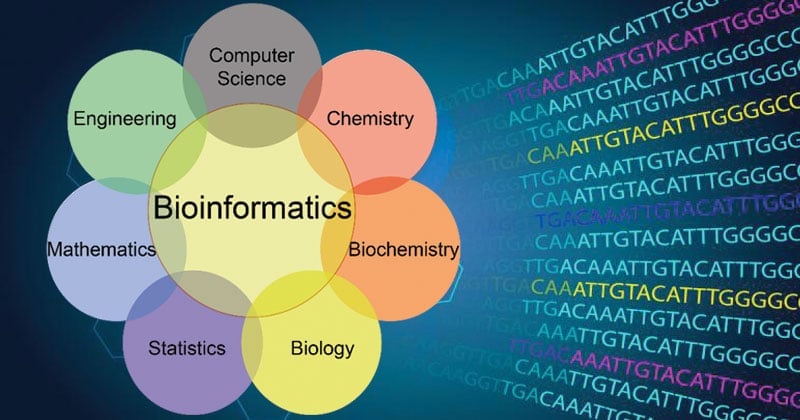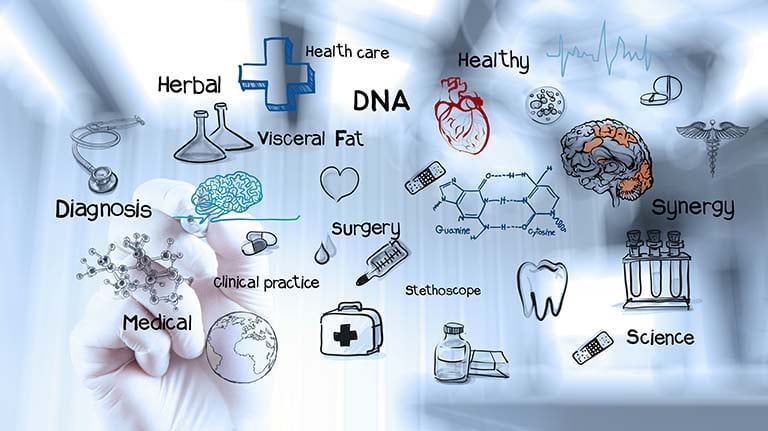- With a large number of prokaryotic and eukaryotic genomes completely sequenced and more forthcoming, access to the genomic information and synthesizing it for the discovery of new knowledge have become central themes of modern biological research.
- Mining the genomic information requires the use of sophisticated computational tools.
- It therefore becomes imperative for the new generation of biologists to initiate and familiarize with a field of study that is concerned with the careful storage, organization and indexing of information in order to tackle the new challenges in the genomic era.
- Information science has been applied to biology to produce a field is called bioinformatics.
- It is concerned with the state of- the-art computational tools available to solve biological research problems.
- The term bioinformatics was coined by Paulien Hogeweg and Ben Hesper to describe “the study of informatic processes in biotic systems” and it found early use when the first biological sequence data began to be shared.
- Bioinformatics is an interdisciplinary field that develops methods and software tools for understanding biological data.
- The development of bioinformatics as a field is the result of advances in both molecular biology and computer science over the past 30–40 years.
- As an interdisciplinary field of science, bioinformatics combines biology, computer science, information engineering, mathematics and statistics to analyze and interpret biological data.
- The key areas of bioinformatics include biological databases, sequence alignment, gene and promoter prediction, molecular phylogenetics, structural bioinformatics, genomics, and proteomics.

Interesting Science Videos
Bioinformatics vs Computational Biology
- Bioinformatics differs from a related field known as computational biology.
- Bioinformatics is limited to sequence, structural, and functional analysis of genes and genomes and their corresponding products and is often considered computational molecular biology.
- However, computational biology encompasses all biological areas that involve computation.
- Bioinformatics as the development and application of computational tools in managing all kinds of biological data, whereas computational biology is more confined to the theoretical development of algorithms used for bioinformatics.
Applications of Bioinformatics
Bioinformatics has not only become essential for basic genomic and molecular biology research, but is having a major impact on many areas of biotechnology and biomedical sciences. The main uses of bioinformatics include:
- Bioinformatics plays a vital role in the areas of structural genomics, functional genomics, and nutritional genomics.
- It covers emerging scientific research and the exploration of proteomes from the overall level of intracellular protein composition (protein profiles), protein structure, protein-protein interaction, and unique activity patterns (e.g. post-translational modifications).
- Bioinformatics is used for transcriptome analysis where mRNA expression levels can be determined.
- Bioinformatics is used to identify and structurally modify a natural product, to design a compound with the desired properties and to assess its therapeutic effects, theoretically.
- Cheminformatics analysis includes analyses such as similarity searching, clustering, QSAR modeling, virtual screening, etc.
- Bioinformatics is playing an increasingly important role in almost all aspects of drug discovery and drug development.
- Bioinformatics tools are very effective in prediction, analysis and interpretation of clinical and preclinical findings.

Applications in Other Fields
Its major applications include in the following fields:
Molecular medicine
- The human genome will have profound effects on the fields of biomedical research and clinical medicine.
- The completion of the human genome and the use of bioinformatic tools means that we can search for the genes directly associated with different diseases and begin to understand the molecular basis of these diseases more clearly.
- This new knowledge of the molecular mechanisms of disease will enable better treatments, cures and even preventative tests to be developed.
Personalised medicine
- Clinical medicine will become more personalised with the development of the field of pharmacogenomics.
- This is the study of how an individual’s genetic inheritence affects the body’s response to drugs.
- Today, doctors have to use trial and error to find the best drug to treat a particular patient as those with the same clinical symptoms can show a wide range of responses to the same treatment.
- In the future, doctors will be able to analyse a patient’s genetic profile and prescribe the best available drug therapy and dosage from the beginning.
Preventative medicine
- With the specific details of the genetic mechanisms of diseases being unravelled, the development of diagnostic tests to measure a persons susceptibility to different diseases may become a distinct reality.
Gene therapy
- In the not too distant future with the use of bioinformatics tool, the potential for using genes themselves to treat disease may become a reality.
- Gene therapy is the approach used to treat, cure or even prevent disease by changing the expression of a person’s genes.
Drug development
- At present all drugs on the market target only about 500 proteins.
- With an improved understanding of disease mechanisms and using computational tools to identify and validate new drug targets, more specific medicines that act on the cause, not merely the symptoms, of the disease can be developed.
- These highly specific drugs promise to have fewer side effects than many of today’s medicines.
Microbial genome applications
- The arrival of the complete genome sequences and their potential to provide a greater insight into the microbial world and its capacities could have broad and far reaching implications for environment, health, energy and industrial applications.
- For these reasons, in 1994, the US Department of Energy (DOE) initiated the MGP (Microbial Genome Project) to sequence genomes of bacteria useful in energy production, environmental cleanup, industrial processing and toxic waste reduction.
- By studying the genetic material of these organisms, scientists can begin to understand these microbes at a very fundamental level and isolate the genes that give them their unique abilities to survive under extreme conditions.
Waste cleanup
- Deinococcus radiodurans is known as the world’s toughest bacteria and it is the most radiation resistant organism known.
- Scientists are interested in this organism because of its potential usefulness in cleaning up waste sites that contain radiation and toxic chemicals.
Climate change Studies
- Increasing levels of carbon dioxide emission, mainly through the expanding use of fossil fuels for energy, are thought to contribute to global climate change.
- Recently, the DOE (Department of Energy, USA) launched a program to decrease atmospheric carbon dioxide levels.
- One method of doing so is to study the genomes of microbes that use carbon dioxide as their sole carbon source.
Alternative energy sources
- Scientists are studying the genome of the microbe Chlorobium tepidum which has an unusual capacity for generating energy from light
Biotechnology
- The archaeon Archaeoglobus fulgidus and the bacterium Thermotoga maritima have potential for practical applications in industry and government-funded environmental remediation.
- These microorganisms thrive in water temperatures above the boiling point and therefore may provide the DOE, the Department of Defence, and private companies with heat-stable enzymes suitable for use in industrial processes
- Other industrially useful microbes include, Corynebacterium glutamicum which is of high industrial interest as a research object because it is used by the chemical industry for the biotechnological production of the amino acid lysine.
- The substance is employed as a source of protein in animal nutrition.
- Biotechnologically produced lysine is added to feed concentrates as a source of protein, and is an alternative to soybeans or meat and bonemeal.
- Lactococcus lactis is one of the most important micro-organisms involved in the dairy industry.
- Researchers anticipate that understanding the physiology and genetic make-up of this bacterium will prove invaluable for food manufacturers as well as the pharmaceutical industry, which is exploring the capacity of lactis to serve as a vehicle for delivering drugs.
Antibiotic resistance
- Scientists have been examining the genome of Enterococcus faecalis-a leading cause of bacterial infection among hospital patients.
- They have discovered a virulence region made up of a number of antibiotic-resistant genes that may contribute to the bacterium’s transformation from a harmless gut bacteria to a menacing invader.
- The discovery of the region, known as a pathogenicity island, could provide useful markers for detecting pathogenic strains and help to establish controls to prevent the spread of infection in wards.
Forensic analysis of microbes
- Scientists used their genomic tools to help distinguish between the strain of Bacillus anthracis that was used in the summer of 2001 terrorist attack in Florida with that of closely related anthrax strains.
The reality of bioweapon creation
- Scientists have recently built the virus poliomyelitis using entirely artificial means.
- They did this using genomic data available on the Internet and materials from a mail-order chemical supply.
- The research was financed by the US Department of Defence as part of a biowarfare response program to prove to the world the reality of bioweapons.
- The researchers also hope their work will discourage officials from ever relaxing programs of immunisation.
- This project has been met with very mixed feelings.
Evolutionary studies
- The sequencing of genomes from all three domains of life, eukaryota, bacteria and archaea means that evolutionary studies can be performed in a quest to determine the tree of life and the last universal common ancestor.
Crop improvement
- Comparative genetics of the plant genomes has shown that the organisation of their genes has remained more conserved over evolutionary time than was previously believed.
- These findings suggest that information obtained from the model crop systems can be used to suggest improvements to other food crops.
- At present the complete genomes of Arabidopsis thaliana (water cress) and Oryza sativa (rice) are available.
Insect resistance
- Genes from Bacillus thuringiensis that can control a number of serious pests have been successfully transferred to cotton, maize and potatoes.
- This new ability of the plants to resist insect attack means that the amount of insecticides being used can be reduced and hence the nutritional quality of the crops is increased.
Improve nutritional quality
- Scientists have recently succeeded in transferring genes into rice to increase levels of Vitamin A, iron and other micronutrients.
- This work could have a profound impact in reducing occurrences of blindness and anaemia caused by deficiencies in Vitamin A and iron respectively.
- Scientists have inserted a gene from yeast into the tomato, and the result is a plant whose fruit stays longer on the vine and has an extended shelf life.
Development of Drought resistance varieties
- Progress has been made in developing cereal varieties that have a greater tolerance for soil alkalinity, free aluminium and iron toxicities.
- These varieties will allow agriculture to succeed in poorer soil areas, thus adding more land to the global production base.
- Research is also in progress to produce crop varieties capable of tolerating reduced water conditions.
Veterinary Science
- Sequencing projects of many farm animals including cows, pigs and sheep are now well under way in the hope that a better understanding of the biology of these organisms will have huge impacts for improving the production and health of livestock and ultimately have benefits for human nutrition.
Comparative Studies
- Analysing and comparing the genetic material of different species is an important method for studying the functions of genes, the mechanisms of inherited diseases and species evolution.
- Bioinformatics tools can be used to make comparisons between the numbers, locations and biochemical functions of genes in different organisms.
References
- Xiong J. (2006). Essential Bioinformatics. Texas A & M University. Cambridge University Press.
- Arthur M Lesk (2014). Introduction to bioinformatics. Oxford University Press. Oxford, United Kingdom
- https://www.britannica.com/science/bioinformatics
- https://www.ncbi.nlm.nih.gov/pubmed/24272431
- https://www.ebi.ac.uk/training/online/course/bioinformatics-terrified-2018/what-bioinformatics
- http://biotech.fyicenter.com/resource/Application_of_Bioinformatics_invarious_Fields.html
- https://www.scribd.com/doc/157668569/Application-of-Bioinformatics-in-Various-Fields
- http://bioinformaticsinstitute.ru/sites/default/files/lapidus_1_0.pdf
- https://www.quora.com/What-are-the-practical-applications-of-bioinformatics

Well researched interesting topics from Mr. SAGAH.